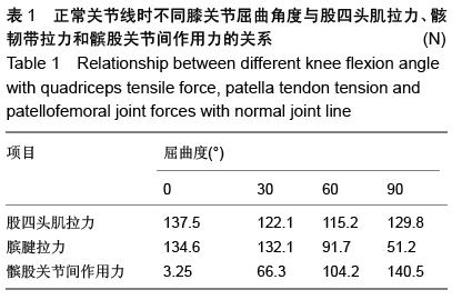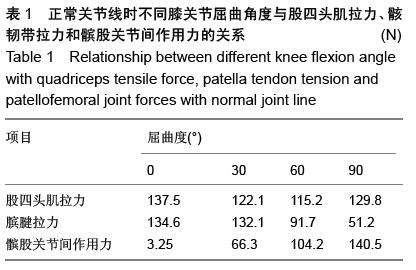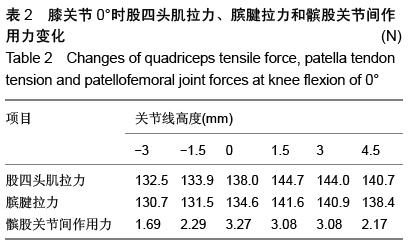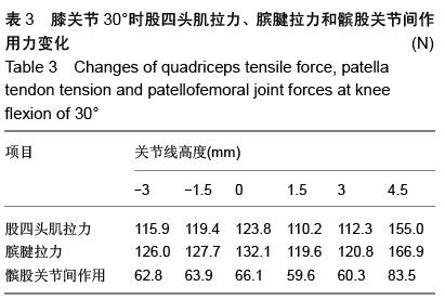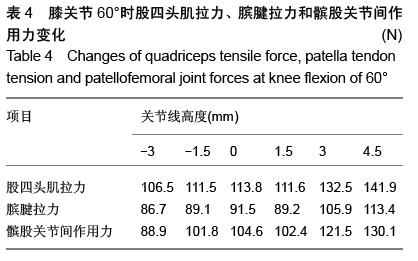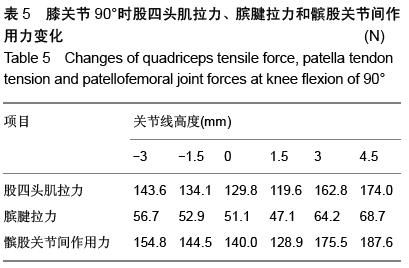| [1] Sato T,Koga Y,Omori G.Three-dimensional lowere xtremity alignment assessment system: applieation to evaluation of component position after total knee arthroplasty.J Arthroplasty. 2004;19(5):620-628.[2] Canale ST, Beaty JH.Campbell's Operative Orthopaedics.12th ed. Philadelphia: Elsevier-Mosby, 2013: 376-444.[3] Beswick AD, Wylde V, Gooberman-Hill R, et al.What proportion of patients report long-term pain after total hip or knee replacement for osteoarthritis? Systematic review of prospective studies in unselected patients. BMJ Open. 2012;2(1): e000435.[4] Schulze A, Scharf HP. Satisfaction after total knee arthroplasty.Comparison of 1990-1999 with 2000-2012. Orthopade. 2013;42(10): 858-865.[5] Williams DP, Price AJ, Beard DJ, et al. The effects of age on patient-reported outcome measures in total knee replacements. Bone Joint J. 2013;95B(1): 38-44.[6] von Keudell A, Sodha S, Collins J, et al. Patient satisfaction after primary total and unicompartmental knee arthroplasty: an age-dependent analysis. Knee. 2014;21(1): 180-184.[7] Matsuda S, Kawahara S, Okazaki K, et al. Postoperative alignment and ROM affect patient satisfaction after TKA.Clin Orthop Relat Res. 2013;471 (1): 127-133.[8] Jacobs CA, Christensen CP. Factors influencing patient satisfaction two to five years after primary total knee arthroplasty. J Arthroplasty. 2014;29(6): 1189-1191.[9] Barrack RL, Ruh EL, Chen J, et al.Impact of socioeconomic factors on outcome of total knee arthroplasty.Clin Orthop Relat Res. 2014;472 (1): 86-97.[10] Clement ND, Jenkins PJ, Macdonald D, et al. Socioeconomic status affects the Oxford knee score and short-form 12 score following total knee replacement. Bone Joint J. 2013;95B (1): 52-58.[11] Vissers MM, Bussmann JB, Verhaar JA, et al. Psychological factors affecting the outcome of total hip and knee arthroplasty: a systematic review. Semin Arthritis Rheum. 2012;41(4): 576-588.[12] Gong L, Dong JY. Patient's personality predicts recovery after total knee arthroplasty: a retrospective study. J Orthop Sci. 2014;19(2): 263-269.[13] Schnurr C, Jarrous M, Gudden I, et al. Pre-operative arthritis severity as a predictor for total knee arthroplasty patients' satisfaction. Int Orthop. 2013; 37(7): 1257-1261.[14] Jacobs CA, Christensen CP, Karthikeyan T. Patient and intraoperative factors influencing satisfaction two to five years after primary total knee arthroplasty. J Arthroplasty. 2014;29 (8): 1576-1579.[15] Li C, Zeng Y, Shen B, et al. A meta-analysis of minimally invasive and conventional medial parapatellar approaches for primary total knee arthroplasty. Knee Surg Sports Traumatol Arthrosc. 2014. [Epub ahead of print].[16] Lau RL, Gandhi R, Mahomed S, et al.Patient satisfaction after total knee and hip arthroplasty. Clin Geriatr Med. 2012;28(3): 349-365.[17] Burnett RS, Barrack RL. Computer-assisted total knee arthroplasty It is currently of no proven clinical benefit: a systematic review. Clin Orthop Relat Res. 2013;471 (1): 264-276.[18] Kim YH, Park JW, Kim JS, et al. Long-term clinical outcomes and survivorship of press-fit condylar sigma fixed-bearing and mobile-bearing total knee prostheses in the same patients. J Bone Joint Surg Am. 2014;96 (19): e168.[19] Lizaur-Utrilla A, Sanz-Reig J, Trigueros-Rentero MA. Greater satisfaction in older patients with a mobile-bearing compared with fixed-bearing total knee arthroplasty. J Arthroplasty. 2012;27(2): 207-212.[20] Schindler OS. The controversy of patellar resurfacing in total knee arthroplasty: Ibisne in medio tutissimus? Knee Surg Sports Traumatol Arthrosc. 2012;20 (7): 1227-1244.[21] Pilling RW, Moulder E, Allgar V, et al. Patellar resurfacing in primary total knee replacement: a meta-analysis. J Bone Joint Surg Am. 2012;94 (24): 2270-2278.[22] Richmond JC.Surgery for osteoarthritis of the knee.Rheum Dis Clin North Am. 2013;39(1): 203-211.[23] Pulavarti RS, Raut VV, Mclachlan GJ.Patellar denervation in primary total knee arthroplasty: a randomized controlled trial with 2 years of follow-up. J Arthroplasty. 2014;29(5): 977-981.[24] Vulcano E, Memtsoudis S, Della Valle AG. Bilateral total knee arthroplasty guidelines: are we there yet? J Knee Surg. 2013;26 (4): 273-279.[25] Lamplot JD, Wagner ER, Manning DW. Multimodal pain management in total knee arthroplasty: a prospective randomized controlled trial. J Arthroplasty. 2014;29(2): 329-334.[26] 接健,夏军.全膝关节置换围手术期镇痛进展[J].国际骨科学杂志,2009,30(5):284-286. [27] 陈焱,王晓宁.全膝关节置换术关节周围注射镇痛疗法的护理配合[J].国际骨科学杂志,2012,33(1):78-79. [28] Thorsell M,Holst P,Hyldahl HC,et al.Pain control after total knee arthroplasty:prospective study comparing local infiltration anesthesia and epidural anesthesia. Orthopedics. 2010;33(2):75-80.[29] Clement ND, Macdonald D, Burnett R. Predicting patient satisfaction using the Oxford knee score: where do we draw the line? Arch Orthop Trauma Surg. 2013; 133 (5):689-694.[30] 郑江,杨镇,张宪,等.全膝关节置换术后疼痛的原因分析[J].陕西医学杂志,2008,37(6):711-712.[31] 孙振辉,刘军,王沛.人工全膝关节置换术后疼痛的诊断和治疗研究进展[J].中国修复重建外科杂志,2010,24(6): 708-711. [32] 刘明,王岩.全膝关节置换术后膝关节疼痛的诊断研究进展[J].中外医疗,2008,7:13-14.[33] 刘明.全膝关节置换术后关节线变化对藤股关节生物力学影响的有限元分析[D].中国人民解放军军医进修学院,2009.[34] 成亮,李康华.全膝关节置换术后并发症的现状与进展[J].中华关节外科杂志,2013,7(2):2 45-247.[35] Khaled JS, Kevin JM, Iasada T. Revision total knee arthroplasty. In: Barrack R, Booth RE Jr, Lonner JH, eds Orthopaedic Knowledge Update:Hip and Knee Reconstruction 3.Chapterll, American Academy Of Orthopaedic Surgeons:New York,2006:139-140.[36] Huizinga MR, Brouwer Rff, Bisschop R, et al. Long-term follow up of anatomic graduated component total knee arthroplasty:a 15 to 20-year survival analysis. J Arthroplasty. 2012;27: 1190-1195.[37] Parsch D,Kruger M, Moser MT, et al. Follow-up of 11-16 years after modular fixed-bearing TKA. Int Orthop. 2009;33:431-435.[38] Mcgraw P, Kumar A. Periprosthetic fractures of the femur after total knee arthroplasty. J Orthop Trauraatol. 2010;11:135-141.[39] Grelsamer RP,Weinstein CH.APPlied biomeehanies of the patella.Clin Orthop Relat Res. 2001;(389):9-14.[40] Iseki F,Tomatsu T.The biomeehanies of the knee joint with sPecial referenee to the eontaet area.Keio J Med. 1976;25(1):37-44.[41] LeRoux MA,Setton LA. Experimental and biphasic FEM determinations of the material properties and hydraulic permeability of the meniscus in tension. J Biomeeh Eng. 2002;124(3):315-321.[42] Li G,Lopez O,Rubash H.Variability of a three-dimensional finite element model constructed using magnetic resonance images of a knee for joint contact stress analysis. J Biomeeh Eng. 2001;123(4): 341-346[43] Mesfar W,Shirazi-Adl A.Biomechanies of the knee joint in flexion under various quadriceps forces.Knee. 2005; 12(6):424-434.[44] Reilly DT,Martens M.ExPerimental analysis of the quadriceps musele force and Patello-femoral joint reaetion force for various aetivities.Acta Orthop Seand. 1972;43(2):126-137.[45] Mason JJ, Leszko F, Johnson T, et al. Patellofemoral joint forees. J Biomech. 2008; 41(11): 2337-2338. |
